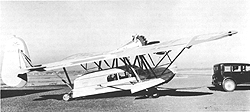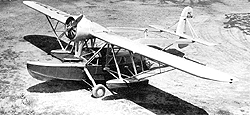

Sikorsky S-39-C
| Manufacturer | Sikorsky |
| Designation | S-39-C |
| Other Designations, if any: | C-28 |
| Aircraft Type | Seaplane |
| Wing Span | 52' |
| Height | 12' |
| Length | 32' 6" |
| Fuel Capacity | |
| Top Speed | 119 mph |
| Cruising Speed | 100 mph |
| Stall Speed | 54 mph |
| Range | 400 miles |
| Empty Weight | 2,678 lbs. |
| Gross Weight | 4,000 lbs. |
| Crew | 2 |
| Service Ceiling | 18,000 feet |
| Engine(s) | 1 x Pratt& Whitney R-985 "Wasp Jr."; 300 hp |
Pratt & Whitney 300 horsepower Wasp Jr. engine’s first flight was early February 1930, and was flown by test pilot, Boris Igor 1. Sikorsky's S-39 was built to meet the demands of the individual pilot-owner. Following the success of the S-38, Sikorsky felt that a market existed for a smaller amphibian intended for the sportsman and executive. The aircraft had a wing span of .52 feet, a wing area of 3.50 square feet, and a gross weight of 4,000 pounds. The aircraft was capable of carrying one pilot plus four passengers. It sold completely equipped for $20,000. The design of the S-39 started in mid-1929 as a twin engine aircraft powered by British Cirrus Hermes Mark I 100 horsepower engines.
The first flight was December 24, 1929. On December 30, the aircraft crashed due to lack of power from one engine. The twin engine concept was abandoned in favor of the smaller plane. Sergievsky commented; "During the first test flight I looped the aircraft." More than 23 S-39s were produced in spite of the Depression. The little amphibian established an enviable service record. The Spirit of Africa, Osa and Martin Johnson's S-39, logged more than 60,000 miles of exploratory flights in Africa. The S-39 established two Aviation World Records, was the first aircraft to use the Pratt & Whitney Wasp Jr. engine, the first aircraft mounted on a private yacht, and the first aircraft designed and produced by Sikorsky after it moved from Long Island to Connecticut.
Search Is On For Sunken Sikorsky
Article from - Pacific Flyer January 2001 - Page B27
Minnesota-based vintage
aircraft collector, Greg Herrick, is after his most elusive prey yet: a
1930 Sikorsky S-39C amphibian that's sitting on the bottom of a lake in Alaska.
Herrick, whose collection
includes such rarities as a 1937 Cunningham-Hall PT 6F, first began his search
for a Sikorsky S-39 years ago. It began like all his other hunts, with a search
for rare types profiled in the late Joe Juptner's nine-volume U.S. Civil
Aircraft series.
Then he combs the FAA register to see how many of a certain type are still
around and who owns them. In 1996, he found three Sikorsky S-39s: one in a
museum, one not salvageable and one whose owner didn't call Herrick back for six
months.
"When he finally did call," reported Herrick, "he told me I could have it but
that I'd have to bring it up from the bottom of a lake." The plane had sunk in
Two Lakes, Alaska., 150 miles west of Anchorage, in 1958 and hadn't been touched
since.
Luckily, Herrick had the resources to continue the search
despite the daunting odds. The tenacious Herrick tracked down the S-39's pilot,
Victor Lenhart, by calling every Victor
Lenhart listed in a nationwide phonebook on the internet.
On the 38th try, he found the 78-year-old Lenhart alive and well in Cornucopia,
Wisconsin.
Lenhart was reluctant to return to the crash site because
of unhappy memories. Although no one was killed in the
mach Lenhart and his
wife lost most of their possessions and their dream of
starting a hunting lodge at Two Lakes. But at Herrick's urging, he flew to
Alaska and to point out where he thought the plane had sunk. Alas, Herrick's
sonar was unable to find the plane.
It was a park surveyor's
map that gave the distance of the wreck from different points on shore that
finally led to the discovery of the S-39-C in 200 feet of water. That was the good
news. The bad news is that the first attempt to lift it ended in failure
last August. Lines hooked to the plane snapped as boats tried pulling it to the
surface. Forced to regroup, Herrick has decided to return to Two Lakes this
spring with a decompression chamber. This will let scuba divers to spend more
time clearing debris from the plane before they try again to lift it.
Plan B is expected to cost $110,000 on top of the $145,000 already spent on the salvage effort so far. "What the hell," said Herrick. "You only live once."
Click HERE for a detailed info PDF file on this aircraft